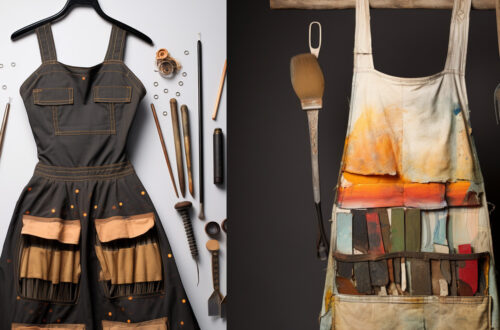
Seize the Now: Adapting the Business Model Canvas for Creativity
Here is the problem; you create great work but it doesn’t get any traction. You put it out into the world and most people seem ambivalent or simply ignore it. Of course, there are a few potential causes for this that may be unrelated to the work; incorrect audience targeting, general lack of visibility and lack of a relevant audience altogether. Today, I’d like to introduce you to a model that can help you to reframe your creative concepts in a way that may help them to resonate with a more specific audience. An audience who potentially understand your work better. Today we are going to look at how to apply Osterwalder’s Business Model Canvas to clarify what our creative identity is in the form of our very own Creative Value Canvas.
- The Art and Structure of Content Creation
- The Creation of ‘Meaningful’ Ideas
- The Benefits of Modelling
- What is The Business Model Canvas?
- The Importance of Value Proposition
- Introducing The Creative Value Canvas
- Getting Started with the Creative Value Canvas (CVC)
- 1. Audience Interests
- 2. Your Personal Interests
- 3. Audience Emotional Gain Topics
- 4. Your Emotional Gain Topics
- 5. Niche Value Proposition
- 6. Products
- 7. Audience Communication Channels
- 8. Research & Development
- Cost Structure and Revenue Streams in Terms of Creative Energy
- The Flow of The Creative Value Canvas
- Closing Thoughts
The Art and Structure of Content Creation
At the time of writing, many new materials are emerging to develop content creators. There are a few common threads across these voices. One is the importance of understanding your audience or your ‘niche’ appeal. While focused on being visual artists, we rarely think of ourselves as content creators. We are the longest standing content creators. There were visual artists creating content for their respective communities long before the written word appeared. There is no content creation more ancient than visual art.
Increasingly I see a parallel to be drawn between the techniques used to focus the efforts of content creators and the process of ‘being creative’ in the traditional sense. I maintain the view that creative thinking develops more effectively with a supporting structure. That’s what this article is about.
The Creation of ‘Meaningful’ Ideas
There is a pre-cursor to this model that we must stress. Your own ideas and concepts are what make you unique as a creator and should be the guiding light for everything you do. What follows here is a proposed method of enhancing what you do – not replacing it. This model is a rod of measure, temperature check or lightning rod if you prefer a stronger analogy. It is meant to take what you do already and enhance its ability to connect to a wider audience.
Finding the Creative Sweet Spot
When we create artwork, we often find ourselves exploring the rabbit warren of our own thoughts and ideas. Some of these are likely so unique to you that they will not be relatable by anyone else and some are so pedestrian and run of the mill as to be inseparable from the mass of thought or the collective public conscious.
Somewhere on this spectrum of value or interest is a sweet spot, a high point in the parabola. The curve drops off at both ends in terms of the ‘value’ or ‘interest’ of the idea, but somewhere in the middle is where you will find your best audience. A point of increased value is somewhere that your unique perspective colors familiar ideas.
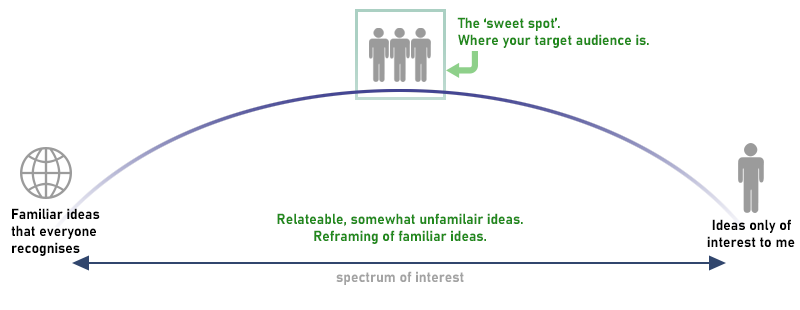
The concept of ‘value’ may be a contentious one. There is an argument that every idea has value if it comes from your genuine creative process. While I go some way to agreeing with this, I also think there are different ways to define ‘value’ in creative work. You might create a piece of work that is meaningless to 99% of the people who view it but resonates with the 1% ( or one person) and that makes it worthwhile of course. For the sake of this exercise, I am defining the concept of value as a quality that makes your work more interesting for your target audience.
The Benefits of Modelling
In my classes this month, we have been learning about business modelling frameworks and the purpose of defining a new start-up idea against a pre-defined structure that helps you define and develop the business concept. It’s an interesting subject in itself. It cast up many thoughts in me about how similar modelling can be applied to our creative practice.
There will be voices of derision I’m sure that rail against the formalisation of creativity in any sense but I believe that all approaches are useful for someone at some time. Often when you are struggling with a paralysis of too many ideas, struggling to get a message across or simply have creative block, a modelling framework can get you back on track.
What is The Business Model Canvas?
If you have never encountered Osterwalder’s Business Model Canvas before then here is a quick overview to get you quickly up to speed on the idea. The Business Model Canvas is a powerful tool for entrepreneurs and business managers, offering a clear and concise way to map out the crucial elements of a business strategy. It’s particularly beneficial for new ventures and projects, as it allows for a comprehensive yet easy-to-digest overview of the business model.
The Components of The Business Model Canvas
It is also a visual way of laying out the following ideas on a grid. This way makes it easier to define the interdependencies between the ‘moving parts’ of the idea. The sections on the grid cover:
- Value Proposition: This core component outlines what makes the business’s products or services unique and attractive to customers. It’s essentially the reason customers would choose this business over competitors. *This and the following point is where I believe the gold lies for creative practitioners.
- Customer Segments: Here, the business defines its target audience. It involves segmenting the market into different groups of customers, each with specific needs, behaviors, or characteristics.
- Customer Relationships: This section details how the business will interact with its customers. It covers customer service, personalized communication, and any strategy for building and maintaining relationships with the customer base.
- Channels: This part focuses on how the business will deliver its value proposition to the customers. Channels can be direct, like an in-house sales team, or indirect, like using third-party retailers.
- Key Partners: This section focuses on the external relationships that are essential to the success of the business. It could include suppliers, distributors, investors, or even strategic alliances with other businesses. Understanding who these partners are and the role they play is critical for the business’s operations and growth.
- Key Activities: Here, you identify the most important activities the business must engage in to deliver its value proposition. This could include manufacturing, marketing, sales, or any other crucial operational task.
- Key Resources: These are the assets required to make the business model work. They can be physical (like manufacturing equipment), intellectual (like patents or data), human (staff, expertise), or financial.
- Cost Structure: This section outlines the costs involved in operating the business. Understanding this helps in making informed financial decisions and identifying where costs can be reduced or optimised.
- Revenue Streams: This part details how the business will earn money. This could include direct sales, subscription services, advertising, or any other means of generating income.
The Business Model Canvas Worksheet
By analysing each of these components, businesses can gain a holistic view of their operations, identify potential challenges and opportunities, and strategically plan for growth and sustainability. This is what the BMC sheet looks like:
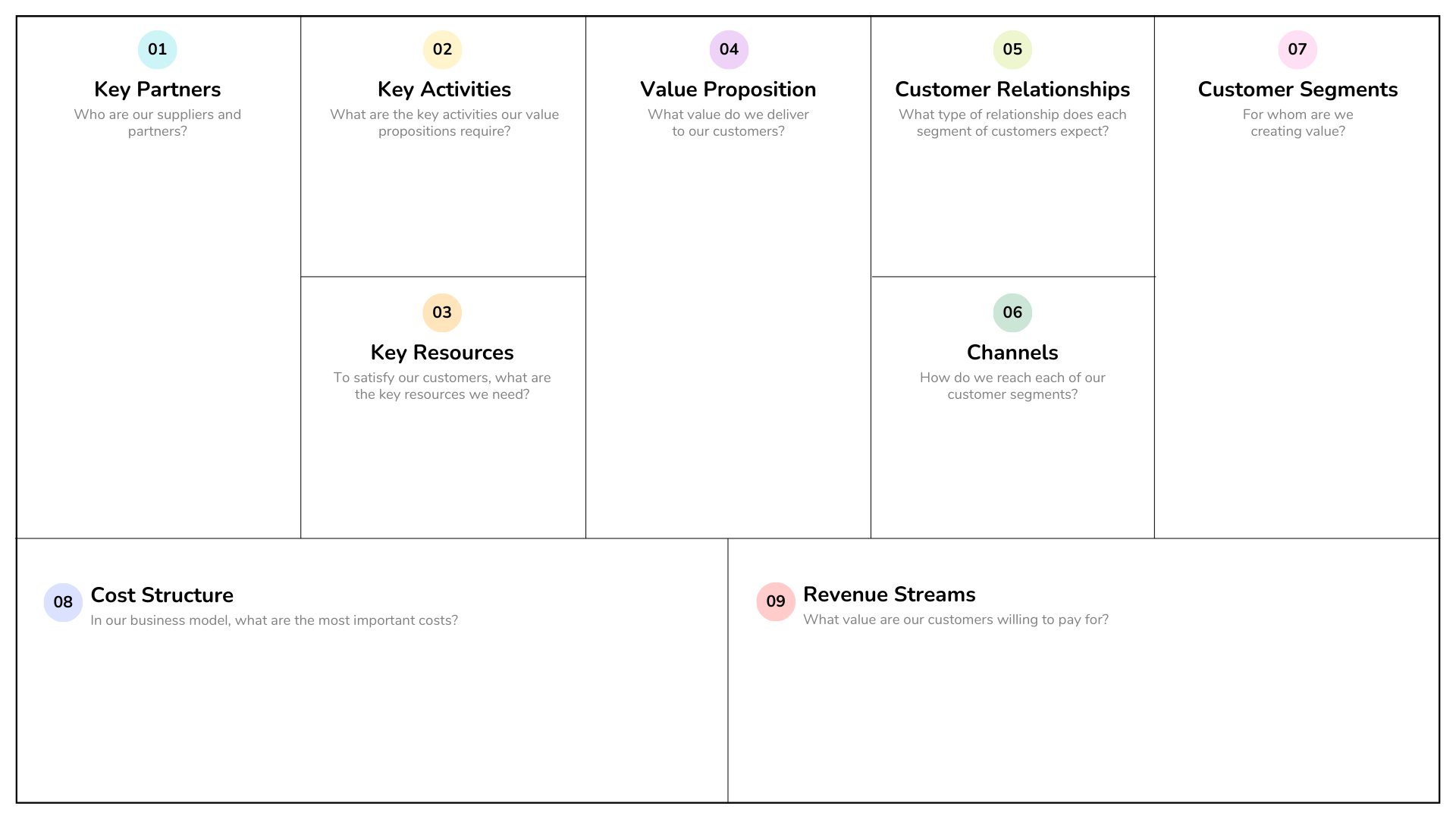
The Business Model Canvas proves its effectiveness by adapting to a wide range of businesses and industries and allowing for updates and revisions as the business evolves.
The Importance of Value Proposition
The concept of value proposition is of paramount importance. Value proposition has it’s own canvas invented by the same people who created the Business Model Canvas. It is worth looking at besides the BMC. Value Proposition defines why you exist as a business and maps what makes your offering match the needs of your potential customers. It is arguably the most important concept on the table.
In conversation with my students last week, we discussed the idea of a value proposition as a visual artist and, of course, there were conflicting views. This mirrors what you will find in the wider creative community. There are some firmly in the Rick Rubin camp who think that creating is a deeply personal act that has value in its own right. I don’t entirely disagree. I would suggest that it depends what your end goal is.
Others, like the idea (as I am proposing here), that you can approach your creative focus in a more calculated manner. The creative thinking consultant, Rod Judkins, is someone subtly advocates for this approach and if you haven’t read his book ‘Make Brilliant Work‘, then treat yourself. This approach encourages you to refine and set a purpose that is in tune with your audience rather than shooting in the dark and hoping something sticks.
Of the two approaches, I have tried both and found the latter to be a better fit for me. It’s important that you work in a way that resonates with your genuine sense of self as a creative practitioner.
What is The Value Proposition Canvas
The Value Proposition Canvas (VPC) explores the idea of meeting your customer’s needs more clearly. It does this by providing a framework to explore the customer in terms of:
- Customer ‘Jobs’ – what are you customers trying to achieve in their day-to-day lives or work roles that you are trying to address with your product or service? This includes mapping your customers’ emotional needs as well as practical needs. It might also cover needs that they are not even aware of.
- Gains – What outcomes and benefits do your customers want? What is it that they expect from a solution. What could make their life easier or exceed their expectations?
- Pains – What annoys or perplexes your customer while they are trying to carry out these ‘jobs’? What are their risks, worries, and anxieties?
We then address these by completing the proposition for your service or product on the left hand side of the canvas where we are addressing:
- Pain Relievers – A description of how your products or services alleviate the frustrations listed above.
- Gain Creators – Describe how the proposed products or services produce customer gains, not only alleviate the pain points but go beyond that to exceed expectations or deliver extra benefits.
- Proposed Products or Services – A description of the products or services you provide or propose to provide.
This is what the Value Proposition Canvas looks like this in it’s original form:
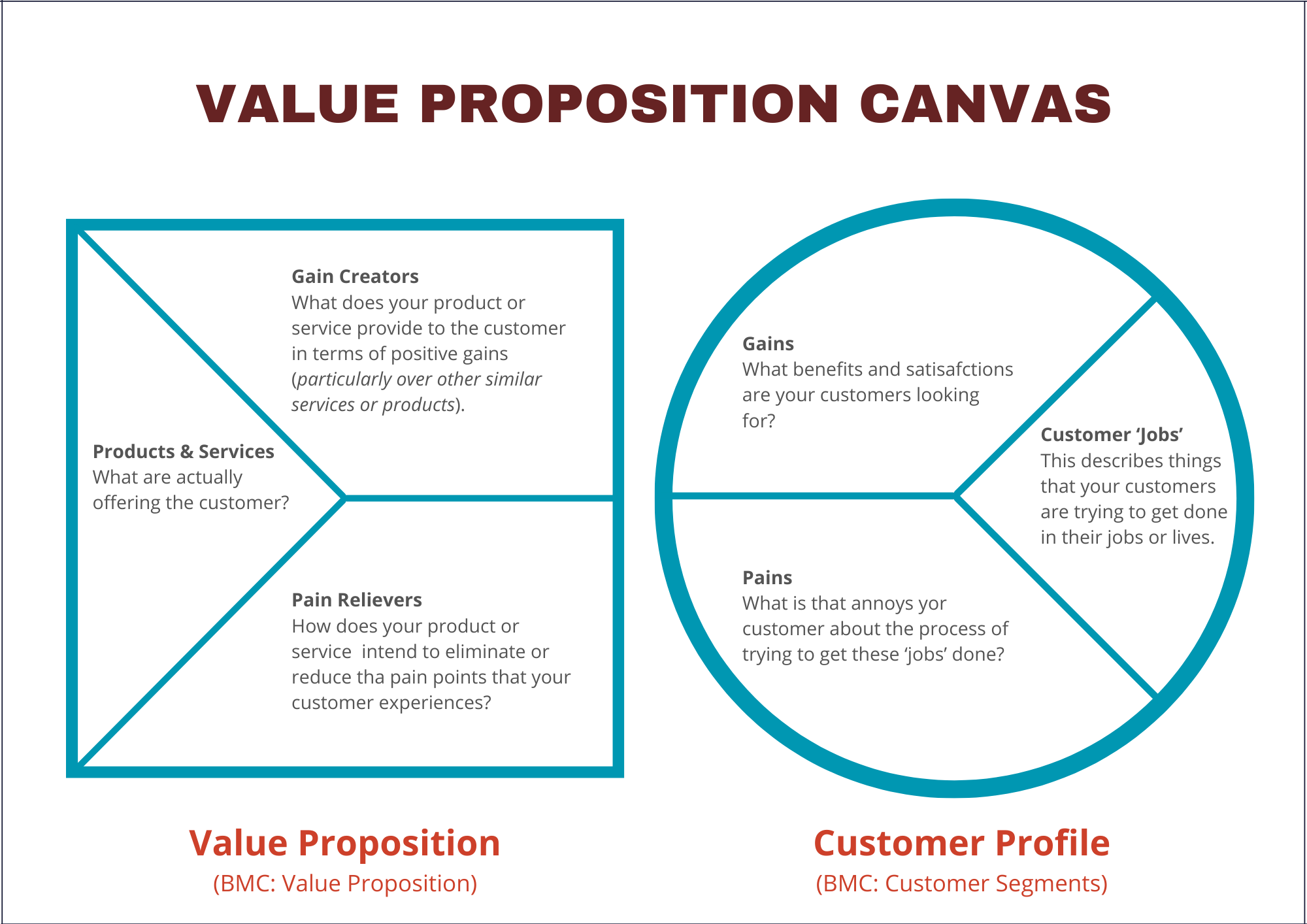
For our purpose, the VPC is just as, if not more, relevant than the BMC above. Both are excellent tools and are something I enjoying working on with business students. Neither of them is an easy or exact fit for creative practice. So let’s take the best parts of the concept and re-purpose
Introducing The Creative Value Canvas
Unlike other models that apply the concepts of the Business Model Canvas to creative projects (which is another exciting way to model for creatives). The Creative Value Canvas (CVC) is about helping you focus your creative output in a way that resonates more effectively with your audience(s). The CVC is designed to help you analyse your creative interests and align them with your audience’s interests and emotional values. I developed this for my students to help them get a handle on what they are about. To give them some tool to think about themselves in a way that engages with the external environment around them rather than isolates them from it.
Unfortunately, I see many students and practitioners early in their career labouring without focus. Many people lack a focused approach so they noodle…for years sometimes. Often, this carries on until they peter out or disappear into invisibility. Often we tire of striving away unrecognised for years because a) you’re not getting any positive re-enforcement and b) you’re not making any money. I’ve been there. You may be there now.
My advice is to step back and re-focus. Use the Creative Value Canvas (CVC) to get a sense of what you are about and what you are aiming for. Follow that up with refining your process and leave the goals out for now. I would argue that time focused goals are not useful for you and may in fact be harmful to your progress. Work with objectives that are not necessarily time bound. That’s a story for another day.
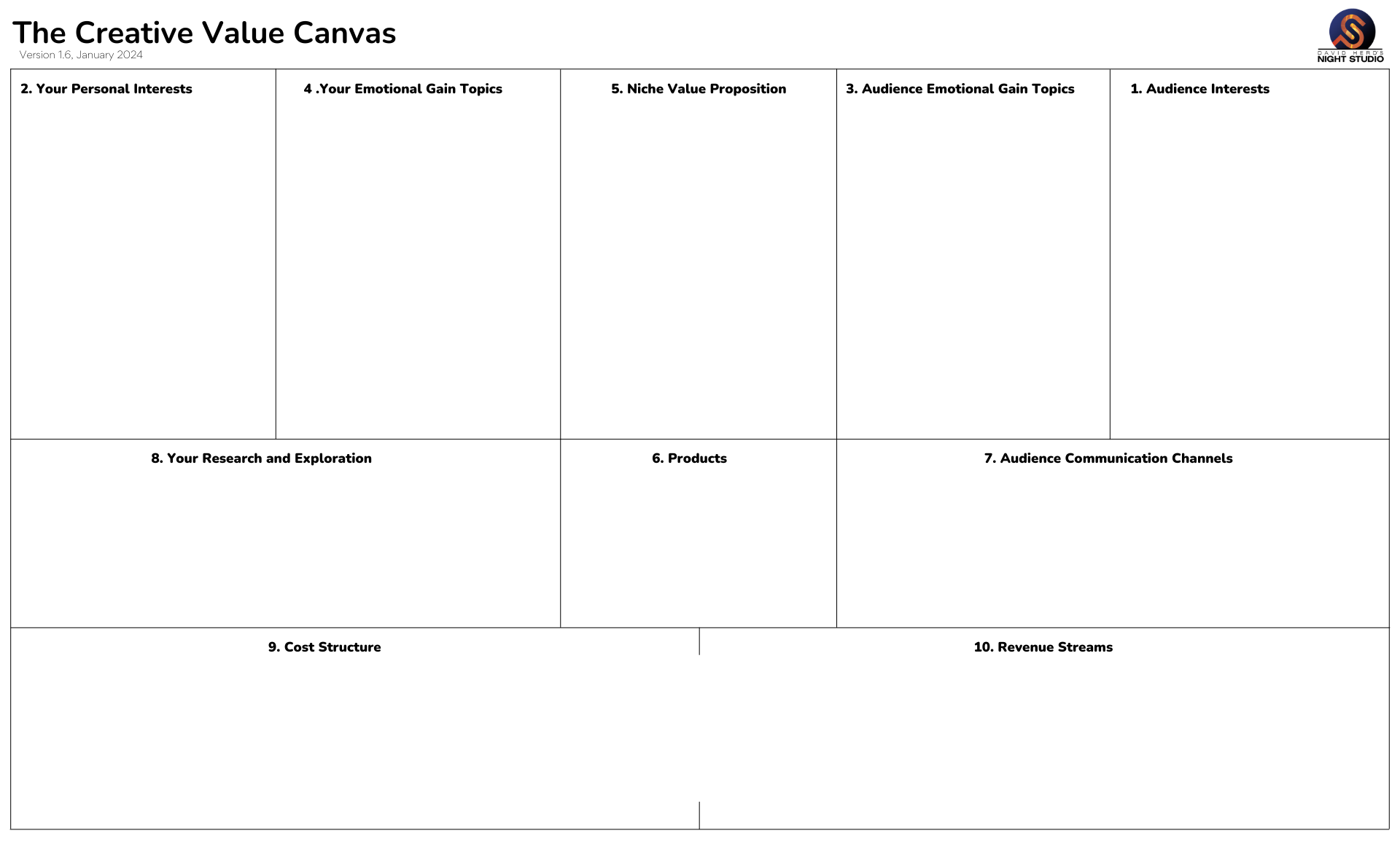
Getting Started with the Creative Value Canvas (CVC)
In this article about being more consistently creative, I wrote about what makes a piece of work resonate with an audience:
Think about a film, TV series or piece of artwork that one of your favourite creators has created. Most likely that piece of work has something about it that makes it unique from other work in the same genre. Now think about what makes that work interesting to you. It is most likely one of the following, that the work:
The Night Studio – ‘How to Be More Consistently Creative at Art’
- resonates with something inside you that you long for or have difficulty verbalising and have not expressed to many other people.
- provides a unique perspective on a situation or combination of familiar factors that are rolled together with unfamiliar elements making the work surprising and unique.
- has a transportative quality that creates a coherent alternative reality that provides an enjoyable sense of escapism from your actual reality.
- expresses something about your current life situation that you cannot express yourself.
We can extract something useful from this that may help us grasp our target audience and theme more successfully. The audience gains that are felt when they connect with a great piece of creative work. One way to define these based on this passage would be as:
- Expresses a very specific emotion, value, or idea that is emotionally relatable
- Presents the idea in a way that is unfamiliar or in combination with another idea not seen before
- Transports the audience beyond everyday existence
- Expresses something about the viewers’ sense of self
Almost every piece of work that I really feel something for includes these three characteristics. This is important. We create work that is a great technical achievement and people will admire it as such, but without establishing an emotional connection to its specific audience, it will never be loved. At this moment, I cannot think of a single exception to this. Every work that I truly feel something for fits this pattern closely.
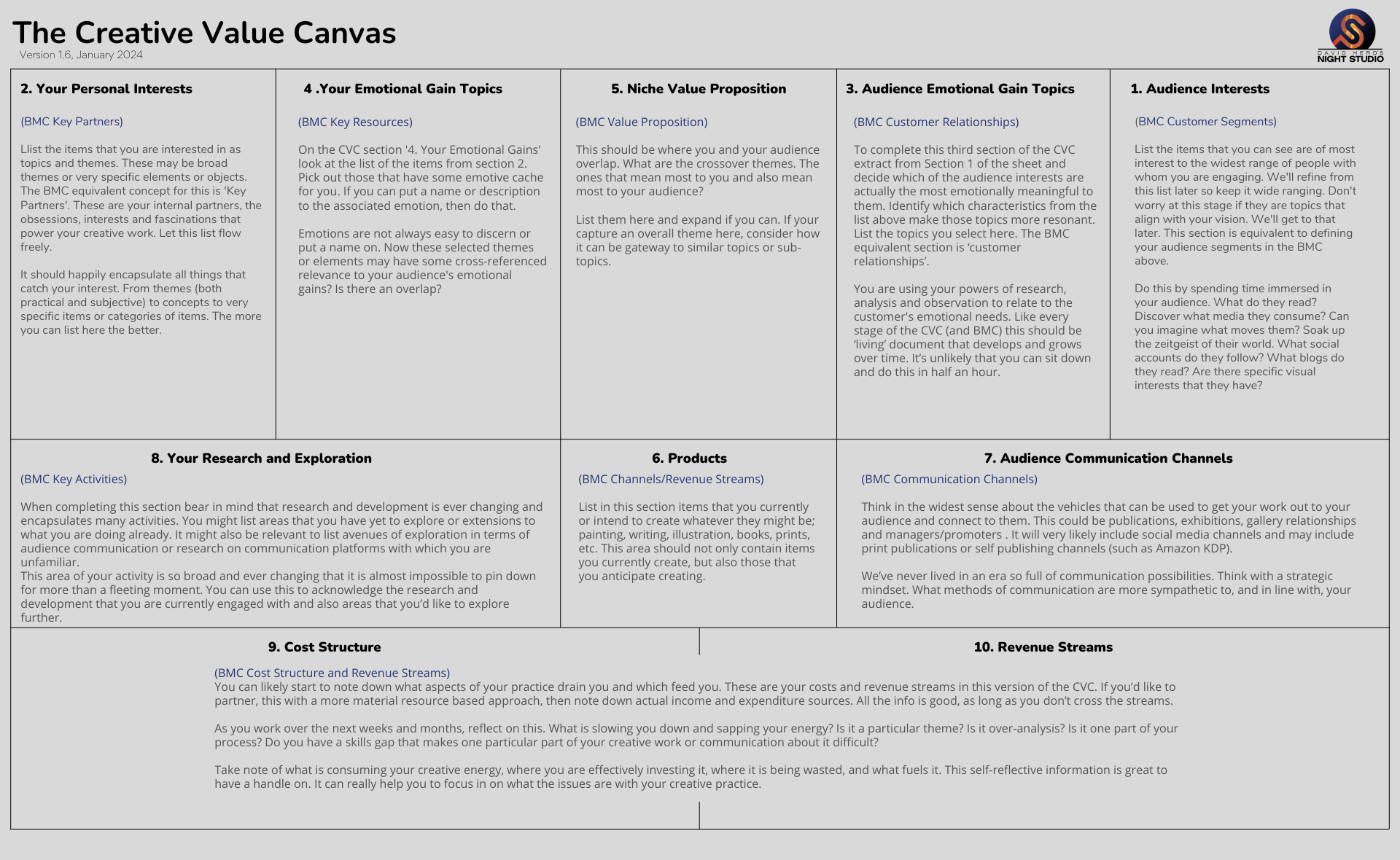
Defining Audience Interest
So how does this help us complete our CVC sheet? When you come to define your Audience Emotional Gain Topics (stage 3 below) from your Audience Interest topics (stage 1 below) look for the potential in the list above. Try to link or crossover themes and values with Your Personal Interests (stage 2 below). This will become your Niche Value Proposition (stage 5 below), potentially the most valuable items in your entire creative value proposition. I’ll remind you when the time comes.
Ready to get started? Let’s walk through this stage by stage.
1. Audience Interests
Business Model Canvas Parallel: Customer Segments
This first stage is akin to understanding your ‘customer segments’ and ‘value proposition’ in the BMC. Here, it’s the audience or market for your creative work. It also shapes the ‘value proposition’ by preparing to align your creative output with the emotional and cultural needs of the audience.
In this context, it’s about identifying and understanding the audience or market for your work. This step is crucial in shaping your ‘value proposition‘, aligning your creative output with the emotional and cultural needs of your audience.
By recognising who your creative work speaks to most (remember Fig.1 above?), you craft a unique message that resonates with their values and aspirations. It’s not just about the aesthetic appeal of your work, but also how it connects with the viewers on a deeper level. You can base this connection on shared concerns, cultural themes, or relatable emotional experiences.
Just like a business develops products or services that meet the specific needs of its customers, as a creative practitioner, you want to create work that appeals to and fulfils the desires or needs of your audience. This alignment enhances the relevance and impact of your work, making it more than just a visual experience – it becomes a conduit for shared values and ideas. This will always make work resonate more deeply.
Completing Section 1: Research the Different Audience Interest Topics
On the CVC section ‘1. Audience Interests’ list the items that you can see are of most interest to the widest range of people with whom you are engaging. We’ll refine from this list later so keep it wide ranging. Don’t worry at this stage if they are topics that align with your vision. We’ll get to that later. This section is equivalent to defining your audience segments in the BMC above.
Do this by spending time immersed in your audience. What do they read? Discover what media they consume? Can you imagine what moves them? Soak up the zeitgeist of their world. What social accounts do they follow? What blogs do they read? Are there specific visual interests that they have?
2. Your Personal Interests
Business Model Canvas Parallel: Key Partners
Just like pinpointing the unique value a business offers its customers, in the creative realm, it’s all about articulating what sets your thinking apart. This stage is about defining the unique themes and elements that make your work distinct. We’ll use this to refine what gives your work unique visual appeal, but also deeply interesting for the right people.
This process involves delving deep into the soul of your practice – exploring and expressing what drives you, what themes or messages you really care about, and how you might combine themes that differ from others. It’s about finding the elements of style, subject and perspective that makes your work unmistakably yours.
Think of this as your creative signature – something that when people see your work, they instantly recognise and connect with on a level beyond aesthetics. There are a very limited amount of genuinely ‘new’ ideas so this is unlikely to be something completely new. Maybe your unique selling point (USP) will be the way you combine some existing ideas or put your own twist on a theme.
Defining what makes your work unique and compelling is about capturing and communicating the essence of your unique thoughts. This is ultimately born from a heightened sense of self-awareness. This is what has driven me to become interested in self-exploration and self-development. It’s the key to how and why you work. This is what draws your audience in and keeps them engaged, providing not just visual pleasure but also a deeper, more meaningful experience.
Successful creative practitioners are utilising well-tuned self-awareness and analysis of the people around them to hone in on a theme that feels very personal but will resonate with a wider audience:
The Night Studio – ‘How to Be More Consistently Creative at Art’
- Being able to combine and synthesise ideas from a diverse range of sources and in particular to place ideas side by side that are not commonly connected with each other, providing a fresh perspective on an (sometimes already existent) idea
- Using well developed technical skills and refined craft to be able to create a convincing alternative version of reality that has that transportative quality
- Having a sense of the zeitgeist, a finger on the pulse of what matters to society and current issues of concern and interest to their audience
Completing Section 2: List Your Own Themes and Interests
On the CVC section ‘2. Your Personal Interests’ list the items that you are interested in as topics and themes. These may be broad themes or very specific elements or objects. The BMC equivalent concept for this is ‘Key Partners’. These are your internal partners, the obsessions, interests and fascinations that power your creative work. Let this list flow freely. It should happily encapsulate all things that catch your interest. From themes (both practical and subjective) to concepts to very specific items or categories of items. The more you can list here the better.
3. Audience Emotional Gain Topics
Business Model Canvas (BMC) Parallel: Customer Relationships
This is where we dive a little deeper and the process becomes less like the BMC and more like the Value Proposition Canvas outlined above (Fig. 3). To connect to your audience, I believe that you have to understand what makes them tick emotionally. What are they looking for in a piece of work? What are the key points that make a piece of creative work mean something to them.
Let’s look back at the list above that defines a relatable piece of creative work:
- resonates with something inside you that you long for or have difficulty verbalising and have not expressed to many other people.
- provides a unique perspective on a situation or combination of familiar factors that are rolled together with unfamiliar elements making the work surprising and unique.
- has a transportative quality that creates a coherent alternative reality that provides an enjoyable sense of escapism from your actual reality.
- expresses something about your current life situation that you cannot express yourself.
The topics that connect with your audience emotionally are in the niche subject area. These are important because they symbolise the values that your audience believe they have. These value topics that connect with your audience emotionally should ideally represent your personal value interests as well.
To be a successful creator, in our modern operating environment, you need to understand your ‘consumer’ or niche audience interests and what they are looking for from a piece of work. You need to spend some time being a consumer of that type of work. Learn what it is that makes your audience really tick.
Completing Section 3: Audience Emotional Gain Topics
To complete this third section of the CVC extract from Section 1 of the sheet and decide which of the audience interests are actually the most emotionally meaningful to them. Identify which characteristics from the list above make those topics more resonant. List the topics you select here. The BMC equivalent section is ‘customer relationships’. You are using your powers of research, analysis and observation to relate to the customer’s emotional needs. Like every stage of the CVC (and BMC) this should be ‘living’ document that develops and grows over time. It’s unlikely that you can sit down and do this in half an hour.
4. Your Emotional Gain Topics
Business Model Canvas (BMC) Parallel: Key Resources
Time to separate the wheat from the chaff. Take everything you wrote down in section 2. Your Personal Interests and consider each one in terms of emotional resonance. Ask yourself a) what emotional impact does this item on the list have for me? and b) can I express what that emotional value is?
Now the job is not to ditch everything that does not illicit a deep emotional response in you. Just to be aware of what does. This may help you read the emotional weather of your audience more effectively when we come to the next part of the process. It should also help you realise what themes and elements mean the most to you and which are more superficial in nature. It may even surprise you. Welcome to self-development. This is you actively raising your self awareness.
It’s easy to rumble along as a creative practitioner thinking that you know what your work is about without ever really sitting down and giving it some analysis. We get stuck in creative habits. Taking the time to even get this far in the process (even if you get no further) should prove useful. I believe that to be the best versions of ourselves creatively; we need to indulge in honest self exploration. This thread should develop alongside your creative practice and they should feed each other.
Completing Section 4: Discovering Your Emotional Gains
On the CVC section ‘4. Your Emotional Gains’ look at the list of the items from section 2. Pick out those that have some emotive cache for you. If you can put a name or description to the associated emotion, then do that. Emotions are not always easy to discern or put a name on. Now these selected themes or elements may have some cross-referenced relevance to your audience’s emotional gains? Is there an overlap?
5. Niche Value Proposition
Business Model Canvas (BMC) Parallel: Value Proposition
If there is a beating heart to the CVC, this is it. This is where your interests meet the interests of your audience and create the possibility of emotional engagement. It has the potential to be the sweet spot where you want to focus your creative efforts for maximum resonance with them. This equates directly to the value proposition of the Business Model Canvas. Your value proposition encompasses many things within the CVC. Of all these, your list of niche value topics has the most potential.
These themes and topics should have the most potential to connect with the people who will understand your work. They are the themes that are closest to your heart and will probably be the ones that resonate most with a portion of people who can understand you better. There is every likelihood that some of these topics or themes might alienate others. You want this to be the case. It will serve you better to be divisive in your interests rather than generic.
Although these topics may have the most potential, they should not be the only threads of work that you develop. We’ll look at other areas within the CVC to grow your interests. You don’t exist as a creative practitioner just to serve an audience…but it is very useful to have a niche audience. Having an audience to whom you can speak honestly is great for your sense of satisfaction, and probably good for your bank balance in the long run.
Completing Section 5: Niche Value Proposition
This should be where you and your audience overlap. What are the crossover themes. The ones that mean most to you and also mean most to your audience? List them here and expand if you can. If your capture an overall theme here, consider how it can be gateway to similar topics or sub-topics.
6. Products
Business Model Canvas (BMC) Parallel: Channels/Revenue Streams
Your products have many purposes; primarily, they express the themes and ideas you are trying to communicate to your audience. They create a record of your creative output and contribute to your catalogue of achievement and exploration and, of course, they provide a transferable item to trade for income. In terms of comparison to the Business Model Canvas, these products serve as both channels for communicating ideas to your audience and potential revenue streams.
In this modeling exercise, I have separated products from communication channels to enable you to think strategically about how you can reach the audience with the products. This seems often to be a weakness in the creative mindset. We become so focused on the product that we forget to develop the channels for reaching the audience. This is one of the guiding principles of this whole modelling exercise.
Completing Section 6: Products
List in this section items that you currently or intend to create whatever they might be; painting, writing, illustration, books, prints, etc. This area should not only contain items you currently create, but also those that you anticipate creating.
7. Audience Communication Channels
Business Model Canvas (BMC) Parallel: Communication Channels
Communication channels feature within the Business Model Canvas as a direct parallel with this section of the CVC. The difference here is for you to describe and explore all the methods of communicating your themes, work, and ideas to your audience. This is the space in which to explore the vehicles for getting your products out to your audience(s). We can be great at creating products, but often not so great at this part. Remember that communication is a two-way channel and that you want to think not only about how you get your message out to the audience but also about how they communicate with you.
Completing Section 7: Audience Communication Channels
Think in the widest sense about the vehicles that can be used to get your work out to your audience and connect to them. This could be publications, exhibitions, gallery relationships and managers/promoters . It will very likely include social media channels and may include print publications or self publishing channels (such as Amazon KDP). We’ve never lived in an era so full of communication possibilities. Think with a strategic mindset. What methods of communication are more sympathetic to, and in line with, your audience.
8. Research & Development
Business Model Canvas (BMC) Parallel: Key Activities
In the creative process, research and exploration are key activities. This is similar to the crucial operational elements in a business’s operations in the Business Model Canvas. Replenishing your internal resources by research and creative experimentation is a central part of your creative development. By participating in these activities you allow yourself to delve deeper into idea development and personal theme exploration. This is how you refine and develop your creative work.
I’ve mentioned before that research within the creative process, transcends simple information gathering. It represents a pursuit for inspiration, new methodologies, and a deeper comprehension of your chosen themes. This might involve studying the works of other practitioners, immersing yourself in diverse cultural exploration, or staying ahead of the latest developments and materials in your area. It’s about expanding your horizons but also about immersing yourself in your themes and personal explorations.
Creative exploration is focused on experimentation and hopefully pushing your comfort zone. While it may involve the tangible process of testing new techniques and materials, it also involves testing ideas and themes. We often don’t know where a theme is going to lead until we start working with it. Exploration is essential to keeping your work innovative and fresh.
The insights, inspirations, and materials garnered through these activities serve as your ‘key resources’. Consider making the CVC part of your research and exploration. Just like you consider the BMC as a living document that evolves over time as your business develops; These key activities and resources are the backbone of your creative process. They should feature in our creative value canvas prominently.
Completing Section 8: Research & Development
When completing this section bear in mind that research and development is ever changing and encapsulates many activities. You might list areas that you have yet to explore or extensions to what you are doing already. It might also be relevant to list avenues of exploration in terms of audience communication or research on communication platforms with which you are unfamiliar. This area of your activity is so broad and ever changing that it is almost impossible to pin down for more than a fleeting moment. You can use this to acknowledge the research and development that you are currently engaged with and also areas that you’d like to explore further.
Cost Structure and Revenue Streams in Terms of Creative Energy
There are many potential ways to view cost and revenue streams in terms of creative work. I’ve thought long and hard about this and how best to encapsulate the idea in a way that is most useful and meaningful. In doing this, I have decided to treat these two elements with one holistic approach and to avoid the materialistic interpretation. My reasoning for this is that we need to focus on process and self-development to make work that is ultimately materially profitable.
It would be easy (and obvious) to state that all things working in sync with the other parts of the CVC that you would hope then to be addressing your audience(s) with more relatable content. This should lead to an increase in material gain if you are also managing to utilise communication channels successfully to get that content out to them. Let’s assume for a moment that is the case. Following from that, the obvious interpretation is that the creation of work costs money (materials, time, etc.) and that you will refill this pot somehow using revenue streams; whatever they may be. Focusing on your process, planning and being more strategic about what you create, I believe, will eventually tick these boxes.
A more important issue to consider is that of your creative energy. This is also a type of currency. It can be spent and it can be invested in and added to. It is vital to your continued success as a creative practitioner that you keep this pot topped up. There are multiple approaches to this but in terms of the CVC you need to keep an eye on what depletes this currency (Cost Structure) and what boosts it (Revenue Streams).
I want you to think of your creative energy as a working part of the creative machine. It is the fuel, and without it you are going nowhere. We’ll look at this issue again in future articles but for now consider this one of your most important moving parts. Your ideas and your creative energy are together what make the work. Both are required.
Completing Sections 9 & 10: Cost Structure and Revenue Streams
You can likely start to note down what aspects of your practice drain you and which feed you. These are your costs and revenue streams in this version of the CVC. If you’d like to partner, this with a more material resource based approach, then note down actual income and expenditure sources. All the info is good, as long as you don’t cross the streams.
As you work over the next weeks and months, reflect on this. What is slowing you down and sapping your energy? Is it a particular theme? Is it over-analysis? Is it one part of your process? Do you have a skills gap that makes one particular part of your creative work or communication about it difficult?
Take note of what is consuming your creative energy, where you are effectively investing it, where it is being wasted, and what fuels it. This self-reflective information is great to have a handle on. It can really help you to focus in on what the issues are with your creative practice.
The Flow of The Creative Value Canvas
There aren’t a lot of ways in which we can capture all of this information in one place, and see the flow and interdependence between the various parts. This is why I have found modelling to be such an interesting experiment when it comes to creative practice and something that I will be sure to explore more in the future. In addition to the blank CVC sheet above I thought it would be useful to show a version with some direction of flow overlaid on it. This might be different for you but it’s how I envisage the flow of ideas and energy according to my first thoughts about this. Hopefully it illustrates how the model can work.
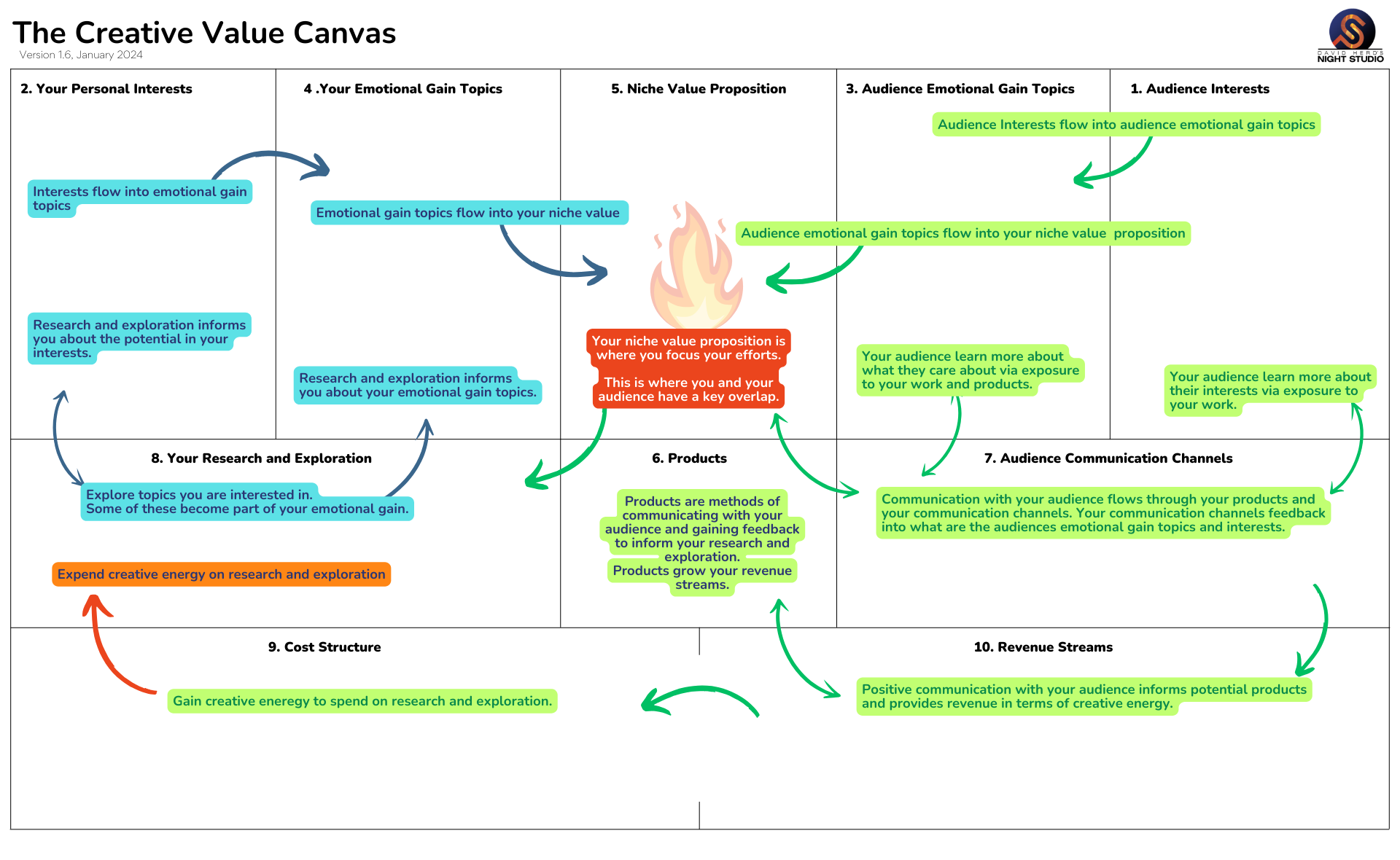
Closing Thoughts
So now I’ve presented this experimental modelling framework for you to try. Please go play with it and let me know if it helps or hinders you. Remember that being creative should mostly be a fun act, if modelling and dissecting of your practice is not for you, that’s no problem. We all work differently and when it comes to creativity, everything is optional, apart from your own sense of fulfilment.





